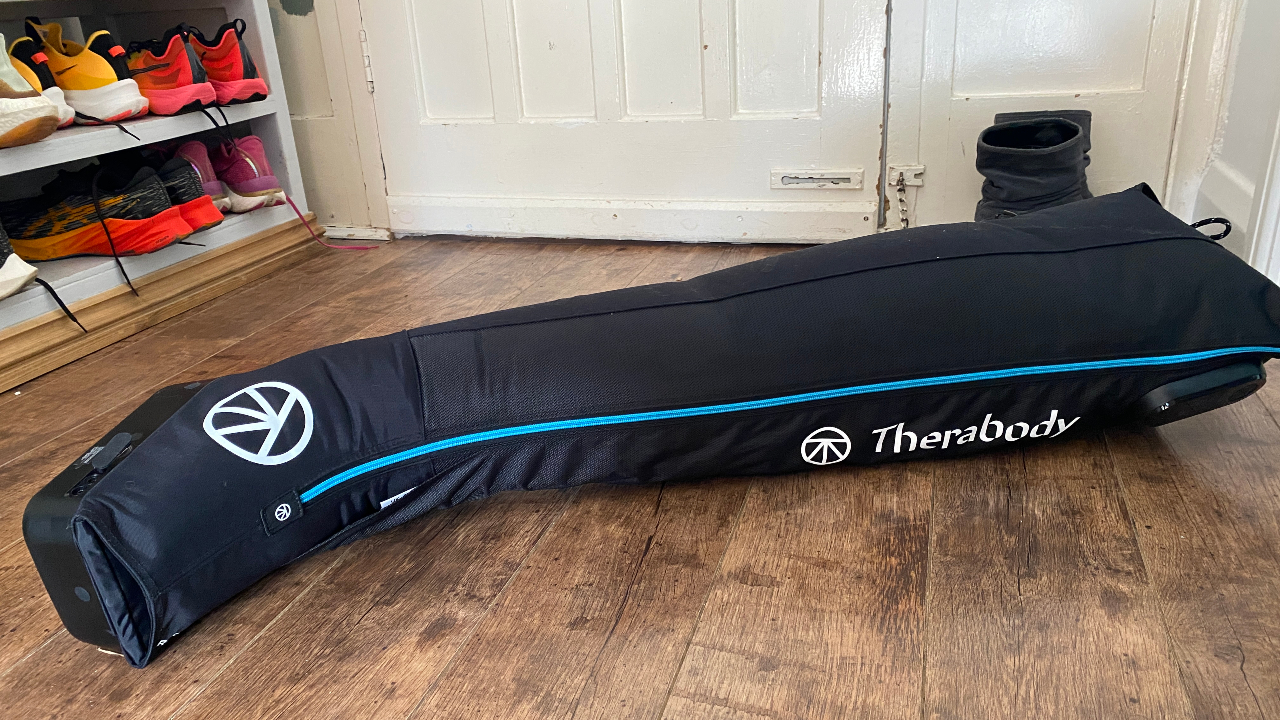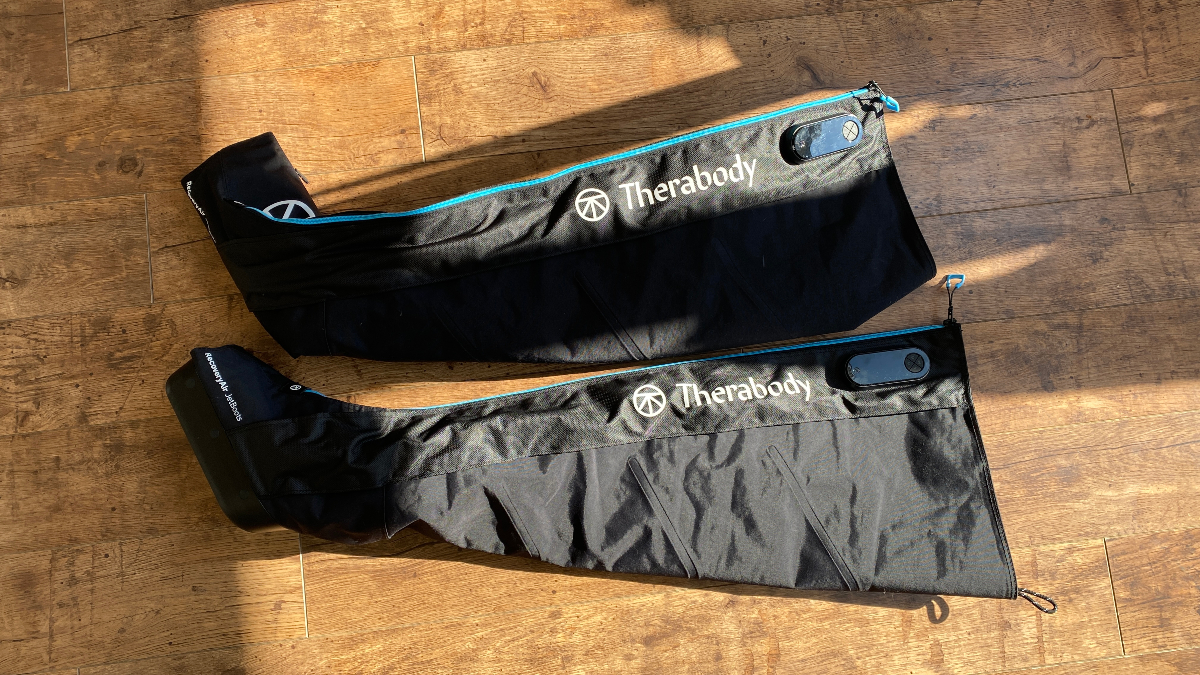Our Verdict
A wireless design and Therabody’s FastFlush technology make the JetBoots effective and easy to use, but you do pay a high price for the privilege.
For
- Wireless design
- Fast flushing for more cycles
- Can be controlled by the app
Against
- More expensive than competitors
- Few customisation options
You can trust Coach
I started testing compression boots during a tough training cycle ahead of the Berlin Marathon, which made the arrival of several sets of leg massagers very welcome. As time went on I found that of all the sets in for review, it was the Therabody RecoveryAir JetBoots that I opted to use time and again, and that almost purely comes down to convenience.
Unlike most compression boots, the JetBoots are wireless, with the console needed to control them being built into the leg sleeve. This saves time and effort setting up the boots on each occasion you use them, and it’s a key reason I rate them as the best compression boots I’ve tested.
Therabody RecoveryAir JetBoots: Price And Availability
The JetBoots are available now and cost $899 in the US and £799 in the UK, which puts them in the middle of Therabody’s range of compression boots. The RecoveryAir Prime boots are cheaper at $699/£599, while the RecoveryAir Pro are $1,299/£1,129. Both of those models use a separate console.
Design

The JetBoots are wireless compression boots with integrated motors in the bottom of the boots and a console at the top of each so you can control them. The boots connect to each other and the Therabody app via Bluetooth.
There are four overlapping chambers that inflate to create pressure that builds from the base of the boots to the top, with four pressure settings available: 25, 50, 75 and 100mmHg. The boots come in three sizes and need to be charged individually, though you can do both at once via the supplied splitter cable. The battery life is listed at 240 minutes.
One of the key features of all Therabody’s compression boots is its FastFlush Technology. The company’s boots inflate and deflate in 60 seconds, which is faster than rival boots and allows for more inflation cycles during a compression session. Therabody says this helps to increase the recovery benefits of its boots.

There are four time options on the boots: 20, 40 and 60 minutes, and a continuous mode. You can adjust all the settings on the boots themselves, or set up your session in the partner app. The range of customisation available is less impressive than on the more expensive RecoveryAir Pro boots, and indeed others I’ve tested, such as the Normatec 3 Legs, where you can choose areas to apply more pressure to and have more levels of pressure to choose between.
Sign up for workout ideas, training advice, reviews of the latest gear and more.
The JetBoots come with a drawstring bag for storage between uses. This sack is not exactly a space-saving solution or easy to carry, but it makes it easier to transport the boots. Other brands, like Recovapro, offer better carry cases with straps and sections to divide up the boots and accessories so they pack down smaller.
User Experience
Most compression boots have a separate wired console that you plug into each boot for every use. It’s not a lot of work, but the fact you don’t have to do it with the JetBoots makes them far more convenient – to the point where I would use them more often.
While you can’t customise the sessions using the boots to the same extent as other recovery boots, I never felt like I was lacking in options with the JetBoots. They provided enough pressure, and simply being able to pull them on and choose the time I had available on the console was all I needed. Some may want a higher pressure setting, though, since the other sets I’ve tested squeeze you tighter.

During the long weeks of marathon training I felt that the JetBoots helped my legs to recover between sessions, and they’re quiet enough to use while watching TV. I sometimes opted to cover the motors at the bottom with a cushion to mute the noise a little, mainly to try and avoid annoying my partner.
The partner app is somewhat limited in what it adds to the JetBoots, and after checking it out a couple of times I tended to just set up my sessions on the boots themselves. I was always able to get through three or four sessions with the boots between charges, but they fell short of the listed 240-minute battery life, perhaps because I almost always had them set at the highest pressure setting.
Are The Therabody RecoveryAir JetBoots Worth It?
The JetBoots offer the benefits of pneumatic air compression in a simpler package than most boots, and while they might lack some of the customisation options you get on other boots, that's a price I’m happy to pay for the wireless design. In my experience you are more likely to use the JetBoots regularly because they are easier to set up.
At $899/£799, the boots are expensive. The Recovapro Air boots offer better value, at $715/£650, and provide more customisation and a better carry case, though they are wired boots. The Normatec 3 Legs are a cheaper option in the US as well at $799 (they’re £899 in the UK, for reasons unknown). Again they are a wired option, but offer more customisation and a greater pressure range.
It all comes back to the wireless design when you consider whether the JetBoots are worth it compared with other models. For me, the simplicity of the JetBoots puts them ahead of the rest.

Nick Harris-Fry is a journalist who has been covering health and fitness since 2015. Nick is an avid runner, covering 70-110km a week, which gives him ample opportunity to test a wide range of running shoes and running gear. He is also the chief tester for fitness trackers and running watches, treadmills and exercise bikes, and workout headphones.

